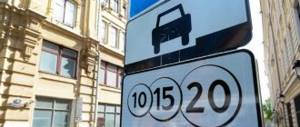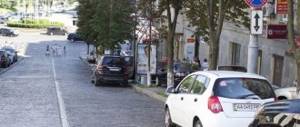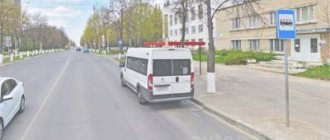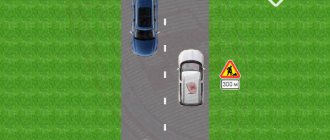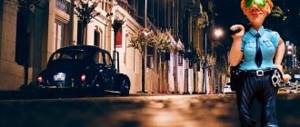A pedestrian zone sign marks a separate area in order to ensure the safe movement of pedestrians. It is often confused with other similar designations, which leads to violation of traffic rules. Drivers risk running into a fine of 500 rubles, since the movement of any type of transport in the area of the sign without additional signs is strictly prohibited. But there is also a sign “Pedestrian traffic is prohibited.”
From the article you can find out how the zone is designated and how it differs from a pedestrian path. It is described when the ban on placing vehicles in a zone does not apply and whether it is possible to drive without violations to the territory where the sign is in force. Various options for recording violations and answers to readers’ questions on the topic are also provided.
Purpose and coverage area of sign 5.33 “Pedestrian zone”
Mandatory pedestrian zone sign. It establishes a special regime, mandatory for all citizens in the area designated by it.
The term is defined by clause 1.2 of the Rules. They designate the territory in a populated area where citizens have the right to move exclusively on foot.
Such a zone begins with road sign 5.33. To determine the end of the pedestrian zone, sign 5.34 is used.
The first is presented in the form of a rectangular plate, in the middle of which there is a circle with a blue background. It depicts the silhouette of a person. At the top above the circle is the inscription “Zone”. Most often, an additional image of a red “snowflake” is placed.
The city usually adds 8.5 signs. They determine the duration of the sign - a clear time period, a specific day or month.
What the road sign prohibits
First of all, the element of road regulation under consideration allows pedestrians to move freely around the space without fear of vehicle traffic. The sign notifies pedestrians that there is no vehicle in the designated area. On the other hand, the “Pedestrian Zone” prohibits drivers from entering the sign’s coverage area and driving in such space.
Sign 5.33 prohibits not only any movement of vehicles in its coverage area, but also its placement in it, be it:
- stopping a vehicle with partial or full entry into a pedestrian area;
- location of the car in the parking lot;
- movement of the vehicle, regardless of speed.
Important! The legislator has provided for the possibility of installing the sign in question on tram and pedestrian streets. In this regard, if there are tram tracks in a pedestrian area, you should be careful when moving near these tracks, since trams are allowed to move along such sections of streets.
Differences between the “Pedestrian zone” and the “Pedestrian path”
Externally, the signs are quite similar and, moreover, both impose a ban on traffic within their range.
However, there are differences between them:
- A pedestrian path is created intentionally for pedestrians, planning it in advance. Whereas a zone is a modified territory adapted for pedestrians, which can be a section of a road. This includes both curbs and adjacent sidewalks. Indicated by the sign “Pedestrian path”.
- Despite the fact that vehicles are prohibited from moving along the path for pedestrians, exceptions are provided. Thus, the established rule can be legally violated by municipal and road maintenance structures if it is necessary to carry out certain work with the participation of special vehicles. In addition, vehicle access is permitted if it is related to loading and unloading of goods, but provided there is no alternative route. As for driving through the pedestrian zone, there is a mandatory rule. If there are no additional signs establishing the expiration period of the sign, vehicles, including mechanical ones, must not violate the restrictions.
- The path for citizens traveling on foot is marked with only one sign at the beginning of the action - 5.4. It ends when it intersects with any road. In turn, two separate signs are provided to mark the beginning and end of the pedestrian zone.
Common mistakes
Error:
entry into a pedestrian zone of transport for the purpose of unloading goods into a retail outlet located in this zone.
Some believe that in the absence of other access routes, it is possible to enter the pedestrian space to load or unload goods or other cargo. In reality, the rules only allow such manipulations in relation to sidewalks and pedestrian paths. And for this act you will have to pay a fine if you cannot get off with a simple warning.
Error:
walking along tram tracks in the area covered by the “Pedestrian zone” sign.
Although this is not directly provided for by the rules, trams can move under sign 5.33, so you should be extremely careful and not go close to the tram routes.
Penalty for driving in a pedestrian zone
If traffic regulations are not followed and sign restrictions are ignored, the culprit faces administrative liability.
It would be a mistake to assume that the violation will be qualified under Part 12.15 of the Administrative Code. This article does not indicate the pedestrian zone and the corresponding restrictions.
Attention should be paid to Article 12.16 of the Administrative Code. The punishment for it is less.
The article punishes drivers who do not comply with the requirements established by road signs.
There are several sanctions. The least involves only warning the violator. More severe - a fine for driving within the limits of the sign. The driver will have to pay 500 rubles for inattention. The difference is noticeable, because in the first case a fine of 1.5 thousand rubles is expected. more.
Drivers should be aware of this feature, since inspectors can take advantage of drivers’ ignorance of the nuances of traffic rules.
Exceptions for the Pedestrian Zone sign
Although sign 5.33 is quite strict for vehicle drivers, it still provides for some exceptions. All of them are presented in the table below.
| No. | Types of transport that can move within the coverage area of the Pedestrian Zone sign | Traffic rules that provide for an exception |
| 1 | Trams | Such an exception is not directly enshrined in the normative act, but follows from application practice. Since tram tracks are difficult to redesign and relocate, in practice they can run along streets that were previously passable and then became exclusively for pedestrians. |
| 2 | Little cyclists under 7 years of age. At the same time, moving specifically through a pedestrian zone or other spaces intended exclusively for pedestrians is not just their right, but also their responsibility. | clause 24.4 |
| 3 | Motor vehicles of road maintenance enterprises, if travel to the pedestrian zone is associated with the repair or maintenance of the road or other elements of the road network or landscaping elements | clause 9.9 |
| 4 | A vehicle such as a bicycle is allowed to move through the pedestrian zone if it is driven by a person aged 7 to 14 years (such young road users are separated into a separate category, since they can also ride on bicycle paths, which they could not do before the age of 7 ) | clause 24.3 |
| 5 | Utility companies have the right to enter the pedestrian zone using specialized vehicles if there is a need to perform relevant work, be it relaying or repairing water pipes, sewerage, painting, washing elements of the space, etc. | clause 9.9 |
Important! The mentioned cyclists do not have the right to interfere with other traffic participants within the pedestrian zone, much less create a danger for them. In such situations (for example, when there is a large flow of people), it is necessary to pick up a bicycle and obey the traffic rules that regulate the behavior of pedestrians.
Currently, people often move around such spaces on scooters, Segways, and other modern mobile vehicles. This is not currently prohibited by law, but the legislator is already working on such a concept as a means of individual mobility in order to regulate this area of traffic at the level of the Rules.
Who is allowed to move in the area covered by sign 5.33
If the “Pedestrian zone” sign is used without additions to it, there is a complete restriction of the movement of any type of transport on the territory. You can only move within the sign's coverage area on foot. Any violations entail liability.
When it is necessary to free part of the city from traffic at a certain time, this sign is temporarily installed.
If signs 8.5 are used with a sign, it prohibits vehicles from moving through the territory only at certain times.
For example, a red o at the bottom of the sign means that restrictive measures are in effect only on weekends and holidays.
During other periods not covered by additional marks, movement is permitted.
The only amendment concerns tram and pedestrian streets. If such a sign is installed on them, trams, in addition to pedestrians, can move along the street.
What is allowed and what is prohibited according to the traffic rules in the area of the sign
The purpose of such a ban is to create comfortable conditions for people traveling on foot, giving them an advantage. As a result of installation, the following is achieved:
- ban on vehicle movement;
- pedestrian safety.
The main requirement of the sign is a complete ban on the passage of cars, including for residents and persons with permits. There are no exceptions for personal wheeled or trackless transport. In this area, it is prohibited to move, park or stop the vehicle, as well as perform any maneuvers.
Trucks for loading or unloading goods, delivery vehicles and other service vehicles are not permitted. To perform their official duties, public utility and special service vehicles may enter the restricted area.
In some situations, the sign is used to introduce temporary restrictions associated with certain events. For example, a ban on the passage of cars on a holiday associated with a parade or procession. This temporary version of the mark does not have any differences in its requirements and restrictions from the permanent one.
Actions that are prohibited to be performed in the area covered by sign 5.33:
- Move using wheeled vehicles on any area: road, roadside, sidewalk or other elements located on the designated area.
- Temporarily stop or park a car for a long time, both on the roadway and on the side of the road, sidewalk or other existing elements of the roadway.
The described prohibitions apply to all mechanical and horse-drawn vehicles, regardless of their speed. If there is a special sign, cyclists are allowed on the pedestrian zone. In the absence of such a sign, their passage is also prohibited.
The only amendment for the “Pedestrian Zone” is streets with organized joint movement of pedestrians and trams. When a prohibiting sign is installed, rail vehicles can still legally move within the specified distance. Such a section is recognized as a tram-pedestrian section with limited access for other vehicles. In addition, the tram has priority on a given street, that is, pedestrians are required to give way to it.
How is an offense recorded?
Employees of the State Traffic Inspectorate and the patrol service can record a violation. Violations are often recorded using automated cameras.
However, recently, notifications from law-abiding citizens have increasingly become the reason for considering cases of administrative violations.
Any citizen, whether a pedestrian or a driver, has the right to record a violation of the Rules himself if he has become an involuntary witness. Usually photo or video recording is used. The materials are handed over to law enforcement officers.
You can contact the inspectorate in person, send an application by mail or online.
The popularity of using a special application on mobile devices is also increasing. The program's functions allow you to record evidence with a guarantee of its originality, report information about the citizen who committed the violation, and even receive bonuses.
Signs 5.33.1 “Bicycle zone” and 5.34.1 “End of bicycle zone”
Sign 5.33.1 “Bicycle zone” marks the beginning of the territory intended for the movement of cyclists. The term “Bicycle zone” was introduced into the traffic rules in December 2021. Despite such a long period of time, the official image of signs 5.33.1 and 5.34.1 has not yet been approved. The figure shows a preliminary image of these signs.
Details about the traffic rules in the bicycle zone, as well as the priority of participants among themselves, can be read in the article Changes in traffic rules from December 14 and 21, 2021.
Cyclists, pedestrians and vehicles can move around the bicycle zone. Cyclists have priority over other participants, and pedestrians in a bicycle zone are allowed to cross the roadway anywhere.
The speed limit for vehicles in the bicycle zone is 20 km/h.
Sign 5.34.1 “End of the bicycle zone” is used to indicate the end of the territory (section of the road) indicated by sign 5.33.1. It is installed at all exits from the territory (road section).

